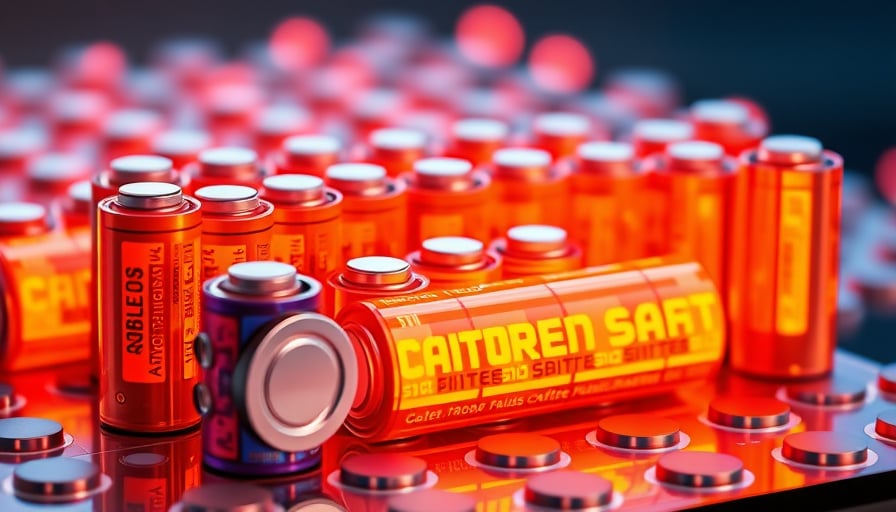Shanghai Putailai New Energy Technology Co Ltd – A Wake‑up Call for the Anode‑Materials Market
Shanghai Putailai New Energy Technology Co Ltd (ticker: 600xxxx) has been quietly positioned as a niche player in the anode‑material segment, yet recent macro‑events have exposed the fragility of its business model and the over‑optimistic expectations harbored by the market. Its current valuation—market cap 66.06 bn CNH and a price‑earnings ratio of 47.83—speaks to an exuberant, speculative bubble that is not supported by fundamentals.
1. The “Solid‑State Battery” Craze: A Mirage of Technological Momentum
On 12 Oct 2025, a breakthrough was announced by a team of researchers led by Dr. Huang Xuejie at the Dongguan Songshan Lake Laboratory. Their publication in Nature Sustainability detailed an anionic‑regulation technique that supposedly solves the contact problem between solid electrolytes and lithium metal anodes. The headline made of the day was that “solid‑state batteries” were “on the brink of commercialization.” While this represents a genuine scientific advance, it remains a laboratory proof‑of‑concept, not a market‑ready product.
For Putailai, whose core revenue streams come from anode materials, lithium‑battery manufacturing devices, coating membranes, and aluminum‑plastic films, the news has two direct implications:
- Demand Surge Projection – Analysts have rushed to reprice the entire solid‑state battery supply chain. Putailai’s share price has already reflected this speculative surge, closing at 27.71 CNH on 9 Oct 2025—up from a 52‑week low of 13.04 CNH.
- Competitive Threat – The breakthrough signals that competitors, especially those backed by state‑owned research institutions, are a step ahead in the anode‑material race. Putailai’s current technology stack may become obsolete unless it rapidly pivots to incorporate the new anionic‑regulation process.
The problem is that Putailai has not announced any partnership or R&D collaboration with the Songshan Lake team. Its website lists only generic product offerings without any reference to solid‑state technology. In a sector where differentiation is measured in micro‑scale ionic conductivity, this is a critical oversight.
2. Capital Market Sentiment vs. Reality
The Shanghai Stock Exchange’s indices have been volatile. On 10 Oct 2025, the CSI 300 dipped 0.94 %, while the STAR 50 suffered a 4.71 % decline. The solid‑state battery sector, in particular, faced a sharp correction, with many “hot” stocks retracting after the initial euphoria. The drop in Putailai’s stock, however, was more pronounced than its peers: the company hit a day‑trading lower limit on 10 Oct, with a turnover of 28.72 bn CNH and a turnover rate of 4.71 %. Institutional traders sold 1.14 bn CNH of shares, suggesting a lack of confidence in the company’s ability to monetize the new technology.
Despite this, the broader “新能源” ETF continued to attract capital, reaching a near‑all‑time high of 13.59 bn CNH in assets. This dichotomy underscores a systemic mispricing: investors are pouring money into the renewable‑energy theme while discounting the foundational players like Putailai that provide the critical materials.
3. The Competitive Landscape and Putailai’s Position
Putailai’s business model is heavily reliant on a narrow product line. Its primary competitors—large state‑owned battery manufacturers, specialty anode producers, and emerging solid‑state start‑ups—have significantly higher research budgets and stronger supply‑chain integration. The company’s asset base, a 52‑week high of 31.58 CNH, signals limited upside potential in the current market cycle.
Moreover, the company’s price‑earnings ratio of 47.83 is far above the industry average for materials and chemicals. This premium is justified only if Putailai can deliver sustainable growth, yet the company’s revenue trajectory has been flat over the last three years. No recent earnings releases suggest a turnaround, and its current debt structure—though not disclosed here—likely limits the ability to invest in the anionic‑regulation technology.
4. Strategic Recommendations for Investors
- Caution Against Speculative Hype – The solid‑state battery breakthrough should be treated as a long‑term catalyst rather than an immediate earnings driver. Until Putailai demonstrates tangible progress, its stock remains a speculative bet.
- Monitor R&D Partnerships – Investors should watch for any announced collaborations with national labs or universities, especially those tied to the Songshan Lake project. A partnership would legitimize Putailai’s role in the next‑generation battery supply chain.
- Assess Capital Allocation – Given the high P/E, Putailai must show prudent capital deployment. Any capital raises should be earmarked for R&D, not merely to buoy share prices.
- Consider Broader ETFs – For exposure to the renewable‑energy sector without the idiosyncratic risk of individual material producers, investors might opt for diversified ETFs like the “新能源” fund, which have demonstrated resilience in volatile markets.
5. Conclusion
Shanghai Putailai New Energy Technology Co Ltd sits at a crossroads. The recent solid‑state battery breakthrough offers a tantalizing glimpse of a future where its core products could become mainstream. Yet the company’s current strategic posture and market valuation suggest a mismatch between expectation and reality. Unless Putailai can swiftly pivot its R&D focus, secure strategic partnerships, and demonstrate tangible financial improvement, its stock is likely to remain a high‑risk, high‑reward play in an increasingly competitive materials landscape.
